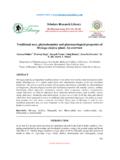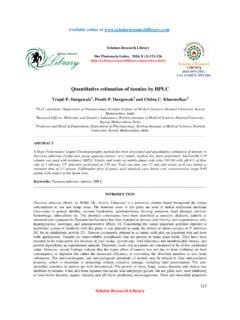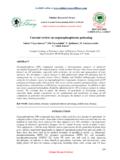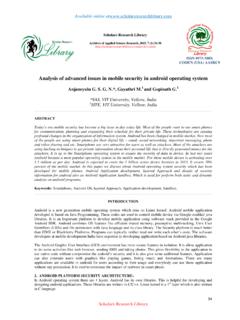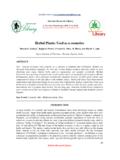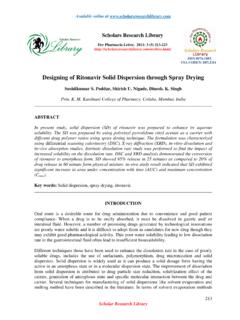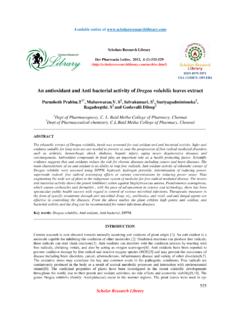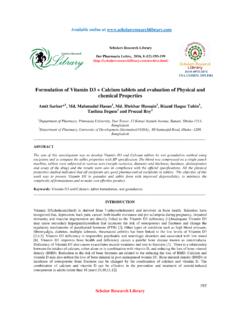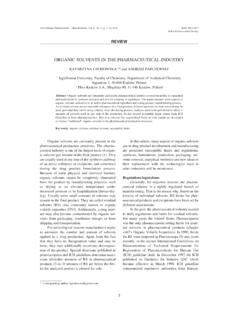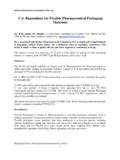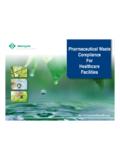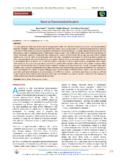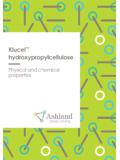Transcription of Genotoxic impurities Evaluation in Active …
1 Available online a Scholars Research Library Der Pharmacia Lettre, 2016, 8 (12):234-243 ( ) ISSN 0975-5071 USA CODEN: DPLEB4 234 Scholar Research Library Genotoxic impurities Evaluation in Active Pharmaceutical Ingredients (API)/ Drug Substance Madhuresh K. Sethi*, Rusha Guha, Rohit Shukla, Sanjay Mahajan, Purbita Chakraborty and Anil Thakan R & D, Mylan Laboratories Ltd., Plot No. 31, 32, 33 and 34 A ANRICH Industrial Estate, Bollaram (Village), Jinnaram (Mandal), Medak (Dt) 502325,Telangana,, India _____ ABSTRACT The main areas discussed in this review are Evaluation of control strategies of Genotoxic impurities at different levels in the manufacturing of Active pharmaceutical ingredients.
2 The acceptable levels and control strategies of various guidelines are evaluated in detail. _____ INTRODUCTION A substance or a compound that is intended to be used in the manufacture of a pharmaceutical product as a therapeutically Active compound, is called as Active pharmaceutical ingredient (API). The manufacturing process of Active pharmaceutical ingredients (APIs) often involve use of reactive materials ( : starting materials, intermediates, catalysts and reagents). These reactive materials along with certain reactive byproducts could remain at trace levels in final pharmaceutical products. Based on their structure and reactivity some of these compounds have been classified as Genotoxic impurities (GTIs).
3 Genotoxic impurities at trace levels, are of increasing concern to both pharmaceutical industry and regulatory agencies as potential human carcinogenic substance [1-6]. The potential consequences of genetic damage that a cell can incur is called genotoxicity. Genotoxicity is the tendency of Genotoxic compounds to attack electron rich centers in DNA generating chemically altered bases [7]. Genotoxic compounds can cause genomic insult by chromosomal alterations or DNA damage by various mechanisms such as intercalation, alkylation and other mechanisms that can lead to mutation of the genetic code. There are many guidelines for Genotoxic compounds, but the regulations are inconsistent and provide unprecise recommendations.
4 Comprehensive and clear guidance for Genotoxic impurities M7 was introduced by EDQM which has provided adequate understating up to certain levels. Genotoxicity assays have become an integral component of regulatory requirements. Sources of impurities in drug substances consist of the following: Starting materials and their contaminants Reagents and catalysts Solvents Intermediates Excipients and their contaminants Madhuresh K. Sethi et al Der Pharmacia Lettre, 2016, 8 (12):234-243 _____ 235 Scholar Research Library Leachable Degradation products Salt and by products which lead to Genotoxic compounds. Figure 1: Flowchart defining starting materials Figure 2: Starting material scientific definition Madhuresh K.
5 Sethi et al Der Pharmacia Lettre, 2016, 8 (12):234-243 _____ 236 Scholar Research Library Figure 3: Various impurities sprouting from the starting material impurities related to drug substances can be classified into three main categories: organic impurities , inorganic (elemental) impurities , and residual solvents. Within these categories, Genotoxic impurities form a special case that poses a significant safety risk, even at low concentrations, because they may be mutagenic and are therefore potentially damaging to DNA. As a result they can lead to mutations or cause cancer. The guidance documents which discuss GTIs are as follows: 1. Guideline on the limits of Genotoxic impurities (European medicines agency [EMA], 2006).
6 2. Genotoxic and carcinogenic impurities in rus substances and products: Recommended approaches (Food and Drug Administration [FDA] draft guidance, 2008). 3. Questions and answers on the Guideline on the limits of Genotoxic impurities (EMA, 2010). 4. M7: Guideline for Genotoxicity The scope of ICH Q3A, Q3B and Q3C is limited to marketed drugs rather than drugs in clinical development. Pharmaceuticals are considered to be the most highly regulated industry, worldwide. There are international and country specific regulatory bodies that ensures compliance in various legal and regulatory aspects of a drug like drug development process, licensing, registration, manufacturing, marketing and labeling of pharmaceutical products.
7 There are international regulatory bodies like International conference on harmonization (ICH), World health organization (WHO), world intellectual property organization (WIPO) which also play essential role in all aspects of pharmaceutical regulations. The international conference on harmonization (ICH) brings together the regulatory authorities of Europe, Japan and USA. Genotoxic impurity classification: Compounds are classified according to their risk potential. Muller et al. proposed a five class system for categorizing Genotoxic impurities [8]. Class 1 impurities known to be Genotoxic (mutagenic) and carcinogenic. This group includes known animal carcinogens with reliable data for a Genotoxic mechanism, and human carcinogens.
8 The Genotoxic nature of the impurity is demonstrated using published data on the chemical structure. Madhuresh K. Sethi et al Der Pharmacia Lettre, 2016, 8 (12):234-243 _____ 237 Scholar Research Library Class 2 impurities known to be Genotoxic (mutagenic), but with unknown carcinogenic potential. This group includes impurities with demonstrated mutagenicity based on testing of the impurity in conventional genotoxicity tests. Class 3 impurities that have an alerting structure unrelated to the structure of the API, and of unknown Genotoxic (mutagenic) potential. This group includes impurities with functional moieties that can be linked to genotoxicity based on structure. However, these moieties have not been tested as isolated compounds and are identified based on chemistry and using knowledge-based expert systems for structure activity relationships (SAR).
9 Class 4 impurities with an alerting structure related to the API and impurities that contain an alerting functional moiety that is shared with the structure of the API. Class 5 No alerting structure or indication of Genotoxic potential. Compounds in class 5 yield negative result in structure alert assessment and hence no additional action beyond normal impurity monitoring is required. Compounds in class 3 and 4 which show positive results are further submitted for mutagenicity testing, with Ames and mini mutagenicity test [9-10]. Figure 4: Potential Genotoxic Structures Characterization and Qualification Madhuresh K. Sethi et al Der Pharmacia Lettre, 2016, 8 (12):234-243 _____ 238 Scholar Research Library Figure 5: Classification of Genotoxic impurities Madhuresh K.
10 Sethi et al Der Pharmacia Lettre, 2016, 8 (12):234-243 _____ 239 Scholar Research Library Figure 6: Flowchart describing identification of Genotoxic impurities and its solution. Adapted from: ICHHT Guideline Q3A (R2) Current step 2006 Genotoxicity assay methods: Genotoxicity of a compound can be tested both in-vitro and in-vivo. One single test cannot provide all information of genetic damage caused by a compound hence a battery of tests are recommended. Genotoxicity assay tests as per the guidelines of FDA are as follows: a) test for gene mutation in bacteria. b) In vitro test with cytogenic Evaluation of chromosomal damage with mammalian or rodent cells. c) An in vivo test for chromosomal damage [11].
